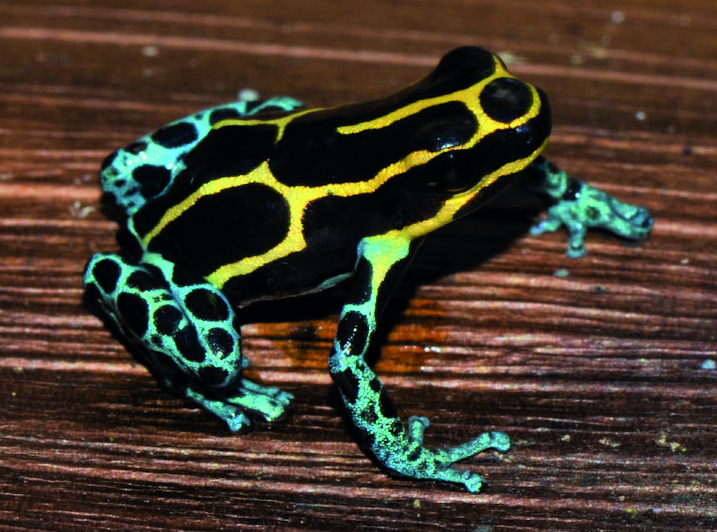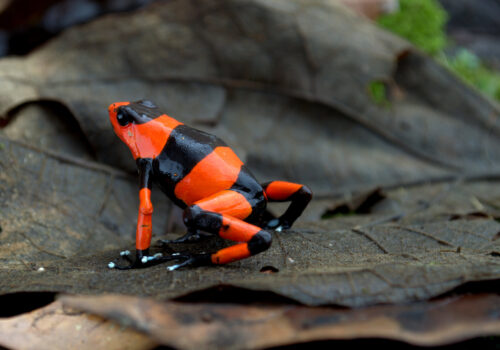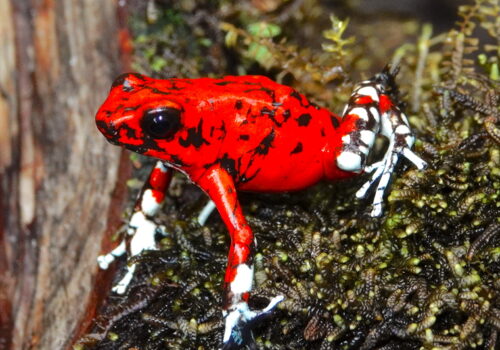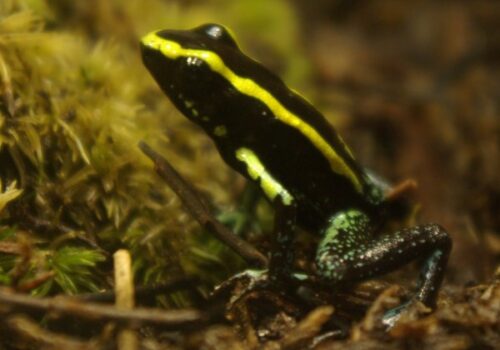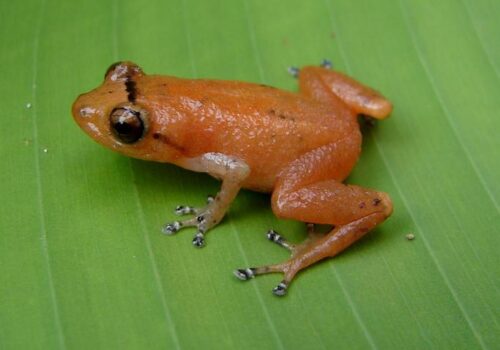- Introduction: Meet Ranitomeya variabilis
- Taxonomy and Classification
- Natural Habitat: A Lush Rainforest Realm
- Physical Characteristics: Nature's Miniature Masterpiece
- Behavior and Life Cycle: Remarkable Adaptations and Parental Care
- Ecological Role: Small Frogs, Big Impact
- Threats and Conservation Status
- Cultural and Scientific Significance of Ranitomeya variabilis
- Conclusion: Guardians of the Amazon's Hidden Treasures
Introduction: Meet Ranitomeya variabilis#
In the lush, emerald depths of Amazonian rainforests, hidden amongst moss-covered branches and delicate bromeliad pools, resides a tiny amphibian whose striking beauty and fascinating lifestyle seem plucked from the pages of a whimsical jungle tale. This remarkable creature is Ranitomeya variabilis, a species of poison dart frog renowned for its vibrant, jewel-like appearance and intricate relationships with its tropical habitat.
Belonging to the family Dendrobatidae, commonly known as poison dart frogs, Ranitomeya variabilis captivates nature enthusiasts and conservationists alike with its bold patterns, incredible adaptability, and intriguing behaviors. Despite its diminutive size—measuring less than two centimeters long—this frog plays a surprisingly significant role in maintaining ecological balance, providing scientists and conservationists valuable insight into the health of their habitat.
Perhaps most captivating is its skin color variation, a trait so pronounced that the species was aptly named “variabilis,” highlighting its kaleidoscopic diversity. From glowing yellows patterned with jet-black stripes to metallic blues woven in intricate mosaic designs, the presence of this tiny amphibian elevates the biodiversity and visual richness of its rainforest home.
Taxonomy and Classification#
Ranitomeya variabilis belongs to the family Dendrobatidae, encompassing the famously colorful and toxic poison dart frogs. Within this family, the frog resides in the genus Ranitomeya, a group known for their incredibly small sizes, arboreal habitat preferences, and vibrant coloration. This genus was established as distinct from Dendrobates largely due to unique behavioral traits and genetic factors discovered through extensive scientific studies.
While closely related frogs such as Ranitomeya imitator share overlapping habitats and somewhat similar color patterns, recent genetic analyses have confirmed the distinct identity of R. variabilis. These subtle genetic nuances have provided valuable insights into the evolutionary pathways of mimicry and coloration, unraveling nature’s clever strategies for survival.
Natural Habitat: A Lush Rainforest Realm#
Geographic Range and Distribution#
Ranitomeya variabilis is endemic primarily to Peru and Ecuador, thriving in lowland tropical rainforests and moist montane regions within the Amazon Basin. Its principal range encompasses humid, densely vegetated areas near rivers and streams—places where moisture and warmth permeate the canopy and forest floor alike, creating ideal conditions for amphibious life.
Preferred Microhabitats#
This frog species is mainly arboreal, spending much of its life perched higher up in trees and bushes, sheltered within bromeliads, hollowed branches, and leaf-littered crevices. Small accumulations of rainwater captured within plant foliage act as miniature nurseries, safe havens in which their offspring develop. Moss-covered logs and shaded undergrowth provide ample hiding places from predators, while maintaining the necessary humidity crucial for the frogs’ delicate skin.
These specific habitat choices also drive a complex interplay between plant growth, insect abundance, and predatory relationships, underscoring how deeply interconnected each member of the rainforest ecosystem truly is. The presence of R. variabilis thus becomes a reliable indicator of habitat quality, offering conservationists critical insights into forest health.
Physical Characteristics: Nature’s Miniature Masterpiece#
A Palette of Colors and Patterns#
At first glance, the tiny stature of Ranitomeya variabilis belies its enormous impact on observers. Adults seldom exceed two centimeters in length, yet their coloration dazzles—brilliantly patterned combinations of electric blues, vivid yellows, fiery oranges, and shimmering greens overlayed by striking black markings. Each individual frog presents a slightly distinct pattern, akin to a personal fingerprint, adding to the species’ overall charm and scientific intrigue.
The Secret of Skin Toxicity#
Like many poison dart frogs, Ranitomeya variabilis secretes powerful alkaloid toxins through its skin glands, a remarkable defensive adaptation evolved to deter predators. Interestingly, the potency and composition of toxins vary geographically and depend largely on the frog’s diet. Their toxicity primarily derives from consuming ants and mites that contain these toxin precursors, revealing a fascinating ecosystem link where prey influences predator survival strategies.
Behavior and Life Cycle: Remarkable Adaptations and Parental Care#
Diet and Hunting Tactics#
Ranitomeya variabilis primarily hunts minute invertebrates such as ants, mites, springtails, and small insects within its arboreal habitat. Using excellent eyesight, agile movements, and swift lunges of a sticky tongue, these frogs expertly navigate their lush environment, capturing prey with incredible precision. Their diet choices enhance their skin toxicity, serving both nutritional needs and defense mechanisms in one efficient evolutionary stroke.
Breeding Habits and Tadpole Care#
This frog species presents a particularly fascinating breeding behavior characterized by extended parental involvement—rare among amphibians. Male frogs establish territories and begin vocalizing—a soft, rhythmic series of chirps—to attract females. Once the female lays eggs inside a bromeliad or small water-filled cavity, the male diligently fertilizes and then guards the developing eggs.
Upon hatching, the male or occasionally the female carefully transports each tadpole individually on its backs to separate water pools, allowing young to grow without competing for nutrients. Females routinely deposit unfertilized eggs in these nursery pools, provisioning their offspring with food to ensure their survival—an act of devoted care that underscores the complexity of social behaviors among amphibians.
Ecological Role: Small Frogs, Big Impact#
Beyond its visual allure and intriguing behavior, Ranitomeya variabilis serves critical ecological functions. As integral predators of insect populations, these frogs aid in controlling pest abundance, thus balancing vegetation health. Simultaneously, their position as prey items for snakes, larger frogs, and birds illustrates their pivotal place in the rainforest’s complex food web. Furthermore, their sensitivity to environmental shifts renders them ideal indicator species capable of signaling early warning signs of habitat deterioration or contamination.
Threats and Conservation Status#
A Fragile Existence Under Threat#
Despite an ability to adapt effectively to precise microhabitats, Ranitomeya variabilis faces ongoing challenges. Habitat destruction from deforestation due to logging, agriculture expansion, and illegal gold mining poses grave threats. Climate change further complicates their survival prospects, altering rainfall patterns crucial for maintaining moisture levels required by this sensitive amphibian.
Current Conservation Efforts#
The International Union for Conservation of Nature (IUCN) currently lists Ranitomeya variabilis as “Least Concern,” reflecting relatively stable populations. However, conservationists regularly monitor populations, documenting changes and advocating habitat preservation efforts. Conservation initiatives range from sustainable rainforest management and law enforcement to captive-breeding programs by wildlife institutions aimed at ensuring genetic diversity and survival should wild populations decline further.
Cultural and Scientific Significance of Ranitomeya variabilis#
Beyond biology, this remarkable frog inspires human cultural narratives and scientific exploration. Indigenous communities recognize poison frogs not just as danger-laden entities but interwoven symbols of rainforest vitality and respect for natural powers. In modern scientific research, examining these frogs’ skin toxins continues to yield promising insights for developing novel medical compounds, including analgesics and cardiac medications.
Conclusion: Guardians of the Amazon’s Hidden Treasures#
The story of Ranitomeya variabilis beautifully illustrates how seemingly insignificant members of an ecosystem profoundly influence ecological balance, cultural storytelling, scientific exploration, and conservation discussions. Immersed within the vibrant tapestry of the Amazon rainforest, this tiny gem of nature serves as a poignant reminder of how tightly we are connected to our world’s biodiversity and why protecting even the smallest inhabitants must become a collective priority.
Join the global community striving to safeguard amphibians and their delicate ecosystems. Learn, advocate, and engage—together, we ensure the thriving continuation of living jewels like Ranitomeya variabilis, guardians of Amazonia’s delicate balance.








